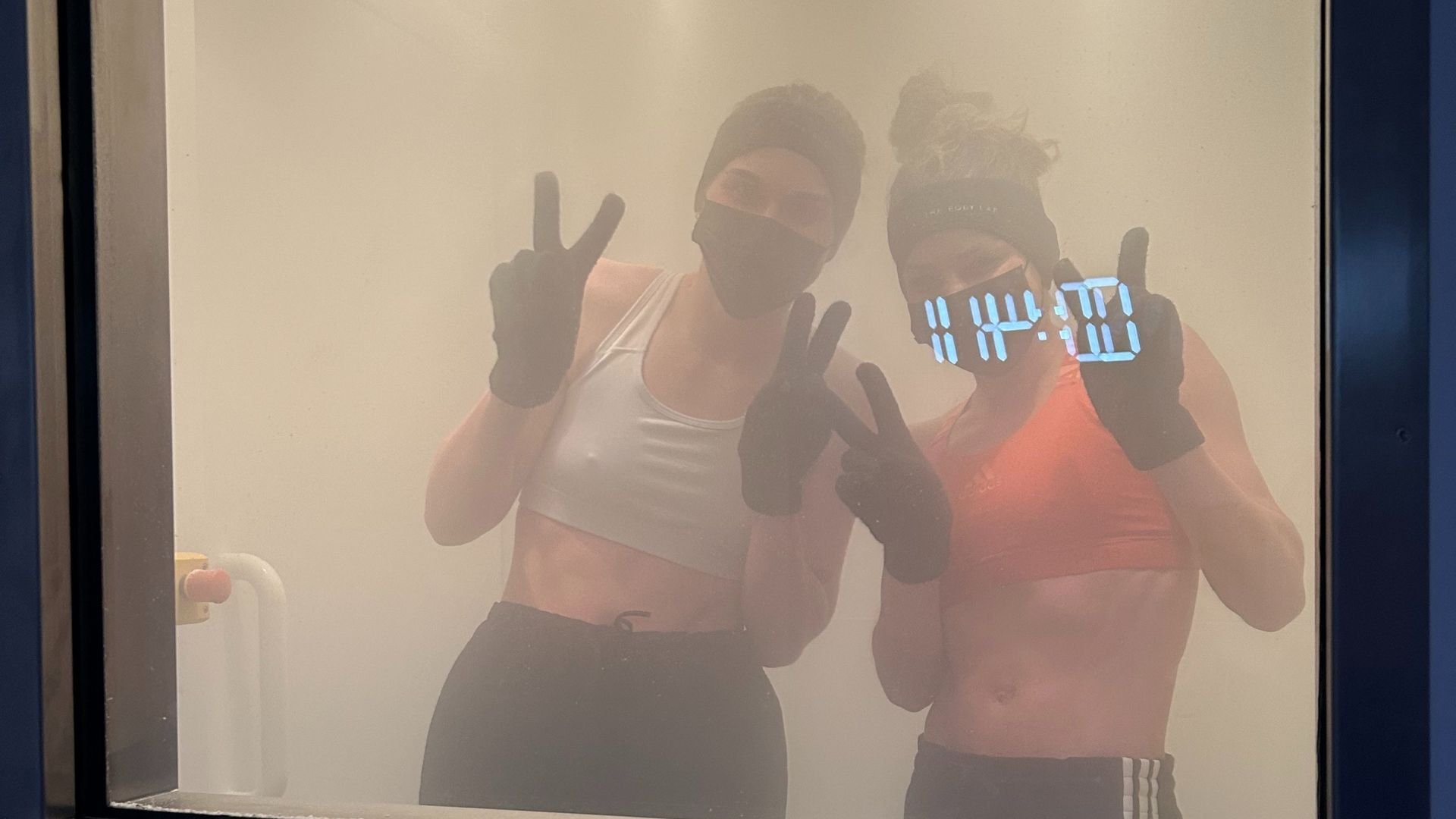Cryotherapy vs Cold Water Immersion: Which Recovery Method is Best?
When considering recovery therapies in the current fitness climate, one stands out as having recently experienced a resurgence in general popularity thanks to fitness influencers: cold water immersion.
Cold water immersion facilitates a similar body response as cryotherapy, with primary differences being how you perform the recovery and the mechanics behind the results. Both are widely used by athletes, fitness enthusiasts, and wellness-focused individuals to reduce inflammation, support muscular recovery, and improve performance.
But which method is more effective—and how do they compare?
Cryotherapy has become a go-to option in our club for fast, consistent recovery support without the discomfort of a traditional ice bath. In this post, we explore the mechanisms, differences, and best use cases for both therapies so you can decide which best suits your recovery goals.
What Is Cryotherapy?
Cryotherapy is one of the fastest-growing recovery tools in modern wellness and performance circles. If you're unfamiliar with it, here's how it works.
Cryotherapy involves brief exposure to extremely cold air. Sessions at The Body Lab see users enter our -60°C pre-chamber to get acclimatised to the cold for 30 seconds. Then, they step into our main chamber, which rests at -110°C for up to two to four minutes.
This rapid cooling triggers a powerful physiological response: blood vessels constrict, blood flow is redirected toward vital organs, and the body begins to release endorphins. Once the session ends, the re-warming process encourages improved circulation, reduced inflammation, and a general sense of recovery and invigoration.
We use cryotherapy as part of a broader recovery strategy, especially for individuals looking to maintain training frequency, reduce soreness, and manage overall fatigue.
For more on the benefits of cryotherapy, consider reading: Discover the Benefits of Cryotherapy.
What Is Cold Water Immersion?
While cryotherapy chambers are a more recent innovation, cold water immersion, commonly referred to as an ice bath or cold plunge, has been a staple in recovery routines for decades.
However, there is a nuance here.
Cold water immersion is an umbrella term that can describe anything that involves submerging one's body or a part of it in cold water. If it includes ice, it is typically known as an ice bath. In a sport or clinical setting, these are typically temperature-regulated to 0-5°C.
A cold water plunge, on the other hand, focuses on resting in a slightly warmer bath at 6–15°C.
In this post, we’re focusing on ice baths specifically when comparing cryotherapy. This is due to their prevalent use for intense recovery and inflammation control in athletes and wellness enthusiasts, which closely resembles the uses of cryotherapy.
Ice baths have long been a staple in professional sports recovery, especially for endurance athletes and team sports players. This method lowers muscle tissue temperature, reduces swelling, and helps prevent delayed-onset muscle soreness (DOMS).
Unlike cryotherapy, which is dry and rapid, ice baths require more preparation and time, and are often perceived as more physically uncomfortable due to their longer duration and wet exposure.
Key Differences in How They Work
Although both therapies aim to support recovery and reduce inflammation, they work differently:
Temperature and Exposure Method
Cryotherapy uses dry air to deliver a more intense cold, but for a shorter time. Some people generally tolerate cold air better than water, which can lead to a clear preference between the two options.
In contrast, ice baths involve a milder cold over an extended period, with full or partial body immersion in water. Due to the submersion and contrast in feel, it's not uncommon for this cold to feel “worse” in comparison.
Nervous System Response
Cryotherapy typically activates the sympathetic nervous system, resulting in a boost in alertness and mental clarity. Ice baths may also trigger this response initially, but are often followed by a parasympathetic "after-drop" effect, creating a calm, relaxed state post-session.
Cellular & Circulatory Effects
Both methods promote vasoconstriction during exposure and vasodilation afterwards, supporting circulation and flushing out metabolic waste.
Cryotherapy also encourages hormonal release, such as adrenaline and endorphins, in a short span, while ice baths focus more on tissue cooling and inflammation reduction.
Which One Is Better for Different Recovery Goals?
Both therapies offer plenty of value. Depending on your goals and how you prefer to incorporate recovery into your routine, you may align better with one method.
Here's how each option supports different aspects of your recovery strategy:
For Post-Workout Inflammation and Soreness
Both cryotherapy and ice baths can help reduce muscle soreness. One of the most common uses of both recovery options is to target DOMS after working out.
Due to their similarities in achieving this, personal preference will be the differentiator between the two. Cryotherapy does, however, have the benefit of being substantially quicker, both in preparation and session length.
For Mental Reset and Energy
Cryotherapy can offer a substantial mental boost, increasing energy and mental clarity. The short sessions are ideal for busy professionals and those needing a quick yet effective reset.
It can also have positive effects on sleep and mood, which can compound total benefits over the course of a day.
While some of these can be achieved through ice baths, the benefits there rely on your ability to enjoy the session and stay in the water for a sufficient period to begin experiencing them.
For more information: Explore the Mental Benefits of Cryotherapy.
For Endurance Recovery or Swelling
Both options have a positive impact on endurance recovery and swelling. Cold water immersion can aid with direct targeting, something with which whole-body cryotherapy cannot.
For example, if you're a long-distance runner or cycler looking to target lower-limb swelling, ice baths specifically can isolate the legs while keeping the rest of you above water.
Whole-body cryotherapy requires your whole body, which can make targeted application more tricky, but it also provides the full range of benefits.
Are There Risks or Downsides to Each?
While both therapies are generally safe, knowing their limitations or contraindications is vital before starting.
Cryotherapy Considerations
Individuals with certain health conditions, such as severe circulatory issues or unmanaged high blood pressure, should avoid cryotherapy. However, it's a safe and highly effective treatment in a controlled, professional setting like our membership club.
Ice Bath Considerations
Cold water immersion can be uncomfortable for many, particularly at home. It also requires more time and setup, and hygiene may be a concern when used communally. Longer exposure times can increase the risk of skin irritation or adverse effects if not monitored.
Safety should also be a primary concern when ice baths are done at home. If you're new to this recovery, having a partner or someone to oversee your sessions is recommended. Additional time in the bath, colder temperatures than intended, and other factors can contribute to additional dangers while undergoing this recovery, such as hypothermia or cardiac shock.
Which Should You Choose?
Choosing between cryotherapy and cold water immersion depends on your goals, schedule, and how your body responds to cold exposure.
If you're looking for a quick, consistent, and invigorating solution, cryotherapy is a convenient and effective choice. Cold water immersion may offer more direct relief for swelling or recovering from high-volume endurance sessions.
Recovery is most effective when it's consistent. Cryotherapy is often an incorporated recovery therapy for our members as it can slot into available openings in a schedule without trouble. Building your schedule around impactful recovery therapies will always be far more effective than adding them here and there.
Frequently Asked Questions
Is cryotherapy more effective than cold water immersion?
Both are effective, but cryotherapy is quicker, many people find it more comfortable, and offers a stronger mental response.
Can I combine cryotherapy and cold water immersion?
Yes, some athletes alternate between both. However, consistency with one method, particularly one as accessible as cryotherapy, often yields better results. Some nuances, such as sport requirements and schedule timing, should be considered when pairing the two.
How often should I use cryotherapy or cold water immersion?
Depending on training volume, cryotherapy is typically used once or twice a week for members to focus on their wellness. Members who use cryotherapy daily are typically those who are athletes or looking to compete.
Cold water immersion is usually less frequent due to preparation time and intensity. It's often used as an "every now and then" option for the average wellness enthusiast. The outlier here is for those who really enjoy it and incorporate it into their daily routine.
For more guidance on Cryotherapy usage, read: How Often Should I Use Cryotherapy?
Does cryotherapy burn more calories than cold water immersion?
Cryotherapy can briefly increase metabolic rate, but neither method should be used solely for calorie burning. For a weight loss focus, consider implementing a range of personal training and reformer pilates, then supporting your recovery with cryotherapy.
Experience Cryotherapy in Our Kensington Club
We've designed our cryotherapy sessions to support your goals and schedule and leave you feeling recharged and recovered.
Book a cryotherapy taster session at our Kensington wellness club to experience it firsthand and see how it can transform your recovery.



